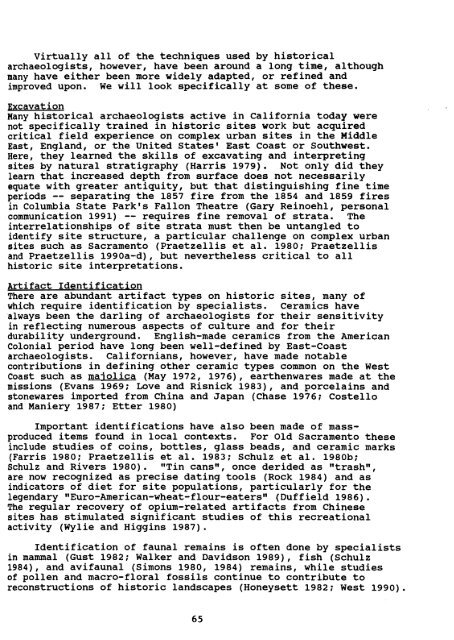SOME OBSERVATIONS ON THE DEVELOPMENT OF HISTORICAL ...
SOME OBSERVATIONS ON THE DEVELOPMENT OF HISTORICAL ...
SOME OBSERVATIONS ON THE DEVELOPMENT OF HISTORICAL ...
You also want an ePaper? Increase the reach of your titles
YUMPU automatically turns print PDFs into web optimized ePapers that Google loves.
virtually all of the techniques used by historical<br />
archaeologists, however, have been around a long time, although<br />
many have either been more widely adapted, or refined and<br />
improved upon. We will look specifically at some of these.<br />
Excavation<br />
Many historical archaeologists active in California today were<br />
not specifically trained in historic sites work but acquired<br />
critical field experience on complex urban sites in the Middle<br />
East, England, or the united states' East Coast or Southwest.<br />
Here, they learned the skills of excavating and interpreting<br />
sites by natural stratigraphy (Harris 1979). Not only did they<br />
learn that increased depth from surface does not necessarily<br />
equate with greater antiquity, but that distinguishing fine time<br />
periods -- separating the 1857 fire from the 1854 and 1859 fires<br />
in Columbia state Park's Fallon Theatre (Gary Reinoehl, personal<br />
communication 1991) -- requires fine removal of strata. The<br />
interrelationships of site strata must then be untangled to<br />
identify site structure, a particular challenge on complex urban<br />
sites such as Sacramento (Praetzellis et ale 1980; Praetzellis<br />
and Praetzellis 1990a-d), but nevertheless critical to all<br />
historic site interpretations.<br />
Artifact Identification<br />
There are abundant artifact types on historic sites, many of<br />
which require identification by specialists. Ceramics have<br />
always been the darling of archaeologists for their sensitivity<br />
in reflecting numerous aspects of culture and for their<br />
durability underground. English-made ceramics from the American<br />
Colonial period have long been well-defined by East-Coast<br />
archaeologists. Californians, however, have made notable<br />
contributions in defining other ceramic types common on the West<br />
Coast such as majolica (May 1972, 1976), earthenwares made at the<br />
missions (Evans 1969; Love and Risnick 1983), and porcelains and<br />
stonewares imported from China and Japan (Chase 1976; Costello<br />
and Maniery 1987: Etter 1980)<br />
Important identifications have also been made of massproduced<br />
items found in local contexts. For Old Sacramento these<br />
include studies of coins, bottles, glass beads, and ceramic marks<br />
(Farris 1980; Praetzellis et ale 1983: schulz et ale 1980b:<br />
Schulz and Rivers 1980). "Tin cans", once derided as "trash",<br />
are now recognized as precise dating tools (Rock 1984) and as<br />
indicators of diet for site populations, particularly for the<br />
legendary "Euro-American-wheat-flour-eaters" (Duffield 1986).<br />
The regular recovery of opium-related artifacts from Chinese<br />
sites has stimulated significant studies of this recreational<br />
activity (wylie and Higgins 1987).<br />
Identification of faunal remains is often done by specialists<br />
in mammal (Gust 1982; Walker and Davidson 1989), fish (Schulz<br />
1984), and avifaunal (Simons 1980, 1984) remains, while studies<br />
of pollen and macro-floral fossils continue to contribute to<br />
reconstructions of historic landscapes (Honeysett 1982; West 1990).<br />
65
















